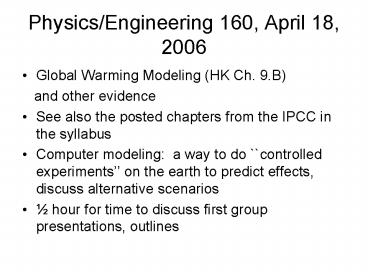PhysicsEngineering 160, April 18, 2006 - PowerPoint PPT Presentation
1 / 18
Title:
PhysicsEngineering 160, April 18, 2006
Description:
See also the posted chapters from the IPCC in the syllabus ... Chaos theory: impossibility of knowing initial conditions with perfect precision ... – PowerPoint PPT presentation
Number of Views:32
Avg rating:3.0/5.0
Title: PhysicsEngineering 160, April 18, 2006
1
Physics/Engineering 160, April 18, 2006
- Global Warming Modeling (HK Ch. 9.B)
- and other evidence
- See also the posted chapters from the IPCC in the
syllabus - Computer modeling a way to do controlled
experiments on the earth to predict effects,
discuss alternative scenarios - ½ hour for time to discuss first group
presentations, outlines
2
Modeling the earths atmosphere/ocean system on a
computer
IBM BLUE GENE MASSIVELY PARALLEL
SUPERCOMPUTER AT LAWRENCE LIVERMORE NATIONAL LABS
3
What should computer based physical models
(General Circulation Models) include?
- Conservation of Energy (energy balance)
- Conservation of momentum (Newtons laws of
force) or angular momentum nonlinear
Navier-Stokes equations - Conservation of mass
- Conservation of water / modeling of clouds
- Equations of state
- ? Atmosphere-ideal gas law
- ? Ocean more complex
- Atmosphere-ocean coupling
- Coupling to biosphere
- Carbon cycle modeling (sinks of carbon)
- Aerosol modeling
- Initial conditions, ongoing conditions,
parameterizations
4
Weather vs. Climate Intrinsic unpredictability I
- The laws of momentum conservation here lead to
intrinsic nonlinearity (Navier-Stokes equations).
Here u is the velocity of a parcel of air or
fluid.
?????? Nonlinearity
5
Chaos theory impossibility of knowing initial
conditions with perfect precision (from
http//www.hallym.ac.kr/physics/education/oregon/
kevan/ph251/113094/113094.html)
Hard wall adds nonlinear response
Slight differences in initial x,v lead to very
different trajectories still, motion is
bounded
6
Measure of sensitivity to initial
conditions-Lyapunov exponents
7
But exponential divergence is shortlived in
bounded systems multidimensional trajectories
confined to attractors ?average behavior
can be well defined
Two dimensional Lorenz attractor for simple model
of the weather time implicit
8
(No Transcript)
9
Following slides are from the IPCC Working Group
1 Summary for 2001 (www.ipcc.ch)
10
Correspondence of projected CO2 stabilization
levels with predicted temperature
11
- Working through carbon cycle models, this shows
various stabilization results for various
reduction scenarios.
12
(No Transcript)
13
(No Transcript)
14
(No Transcript)
15
Potential impact of temperature increase on
Greenland pack and sea level rise
16
Geography of temperature changes from one model
with one carbon dioxide scenario
17
Geography of precipitation variation from two
models with two different emissions scenarios
18
(No Transcript)































